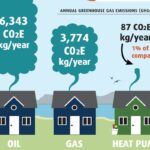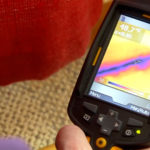As I See It: Home Energy Scores aren’t the answer – Corvallis Gazette-Times
Energy Disrupter

Is there a climate crisis? Absolutely!
Does the city of Corvallis have a responsibility to do something about it? Absolutely!
But let’s do something that makes a difference. Mandating a Home Energy Scores program isn’t it.
Just how much damage is being done to our atmosphere and how much might mandating Home Energy Scores help?
Imagine filling a bowl with 50,000 grains of rice. Each grain represents 1 million tons of greenhouse gases being released into the atmosphere each year, totaling nearly 50 billion tons in 2019.
China is the largest greenhouse-gas emitter, at 12.06 billion tons. Our country is second largest, at 5.72 billion tons.
Oregon’s share of the problem? Under 65 million tons in 2019. A tiny handful of 65 grains of rice.
People are also reading…
And here in Corvallis, what’s our contribution to the climate crisis? City data show we emitted 1,298,351 tons of greenhouse gases in 2018. That’s less than 1⅓ grains of rice in that bowl of 50,000.
Mandating Home Energy Scores will have next to no measurable impact on reducing climate change. The “Electrify Your Life” webinar by Electrify Corvallis shows the typical home emits 3 to 5 tons a year of greenhouse gases in electricity used, 4 to 8 tons a year with a gas furnace and 1 to 3 tons a year with a gas water heater. At worst case, that’s 16 tons per year per house.
Seven hundred seventy-two homes were sold here last year. If every owner had made all the recommended changes, it would’ve saved 12,352 tons of greenhouse gases. That is 124/10,000th of one grain of rice (0.01235 of 1 million tons).
Corvallis cannot solve the world’s greenhouse gases problem. China alone emits 3.3 million tons every day. That’s more than 2 1/2 times what Corvallis emits in a year.
Corvallis has lots of problems of its own that need solving:
We have hundreds of unhoused people desperately in need of shelter, food, clothing, medical care and hope.
The lack of affordable housing here is beyond belief. By the city’s own count, we’re short about 5,000 housing units just to begin to meet demand.
Interestingly, a lot of that demand comes from the 20,777 vehicles commuting here daily for work. Forty percent of those commuters would prefer to live here. Just think what a truly large positive impact it would have on our greenhouse gas emissions if all those vehicles weren’t sitting in long lines of traffic on Harrison Boulevard every morning and Van Buren Avenue every night.
Speaking of Corvallis’ streets, have you noticed what a sorry state so many of them are in? More potholes and patches than original asphalt.
Have you walked along the downtown waterfront lately? Did you see all the bushes that are dead or missing? The artistic trash receptacles with no flowers atop them and gray trash cans, often overflowing, chained to them? The graffiti-covered benches in need of stain? Do you remember when our Riverfront Commemorative Park used to be beautiful?
Speaking of good memories, do you recall when Corvallis was relatively free of property crimes? City data show that from 2020 to 2021, vandalism crimes were up 39%. In the first quarter alone of this fiscal year, stolen vehicles are up 28%, and bike thefts are up 10%.
Do you think Corvallis residents will agree that diverting police officers from dealing with rising crime problems and making them energy police handing out $500 fines for not getting a Home Energy Score is good government?
I’ll end where I began: Is there a climate crisis? Absolutely! Does the city have a responsibility to do something about it? Absolutely!
But let’s do something that makes a difference. Mandating Home Energy Scores isn’t it.
Curtis Wright led the political action committees that helped pass the 2019 Corvallis livability levy, the 2019 Emergency Services District, the 2018 Corvallis school improvement bonds and the 2017 Benton County health and safety levy. He is also past chair of the Corvallis Budget Commission.
#lee-rev-content { margin:0 -5px; } #lee-rev-content h3 { font-family: inherit!important; font-weight: 700!important; border-left: 8px solid var(–lee-blox-link-color); text-indent: 7px; font-size: 24px!important; line-height: 24px; } #lee-rev-content .rc-provider { font-family: inherit!important; } #lee-rev-content h4 { line-height: 24px!important; font-family: “serif-ds”,Times,”Times New Roman”,serif!important; margin-top: 10px!important; } @media (max-width: 991px) { #lee-rev-content h3 { font-size: 18px!important; line-height: 18px; } } #pu-email-form-opinion-email-article { clear: both; background-color: #fff; color: #222; background-position: bottom; background-repeat: no-repeat; padding: 15px 0 20px; margin-bottom: 40px; border-top: 4px solid rgba(0,0,0,.8); border-bottom: 1px solid rgba(0,0,0,.2); display: none; } #pu-email-form-opinion-email-article, #pu-email-form-opinion-email-article p { font-family: -apple-system, BlinkMacSystemFont, “Segoe UI”, Helvetica, Arial, sans-serif, “Apple Color Emoji”, “Segoe UI Emoji”, “Segoe UI Symbol”; } #pu-email-form-opinion-email-article h2 { font-size: 24px; margin: 15px 0 5px 0; font-family: “serif-ds”, Times, “Times New Roman”, serif; } #pu-email-form-opinion-email-article .lead { margin-bottom: 5px; } #pu-email-form-opinion-email-article .email-desc { font-size: 16px; line-height: 20px; margin-bottom: 5px; opacity: 0.7; } #pu-email-form-opinion-email-article form { padding: 10px 30px 5px 30px; } #pu-email-form-opinion-email-article .disclaimer { opacity: 0.5; margin-bottom: 0; line-height: 100%; } #pu-email-form-opinion-email-article .disclaimer a { color: #222; text-decoration: underline; } #pu-email-form-opinion-email-article .email-hammer { border-bottom: 3px solid #222; opacity: .5; display: inline-block; padding: 0 10px 5px 10px; margin-bottom: -5px; font-size: 16px; } @media (max-width: 991px) { #pu-email-form-opinion-email-article form { padding: 10px 0 5px 0; } }
















